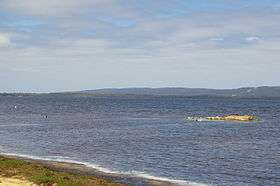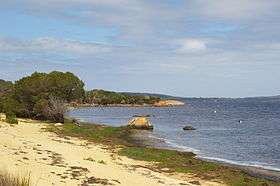Wilson Inlet


Wilson Inlet is an inlet located in the Great Southern region of Western Australia.
Description
The inlet receives water from the two main rivers: the Denmark River and the Hay River and some smaller rivers and streams such as the Sleeman River, Little River and Cuppup Creek. It is located 2 kilometres (1 mi) South East of the town of Denmark.
The inlet is a wave dominated estuary with an opening mouth that has a width of 100 metres (328 ft) with a bar blocking it from late January to August. The inlet is separated into two basins, the Eastern and Western basin.[1]
The estuary is situated on a narrow coastal plain between granite hills to the north and the west and the coastal dunes to the south. The area of the inlet is 48 square kilometres (19 sq mi)[2] and has an average depth of 1.8 metres (6 ft) and its deepest point is 5 metres (16 ft). The inlet is 14 kilometres (9 mi) long from East to West and has a width of 4 kilometres (2 mi)
The inlet has a total catchment area of 2,263 square kilometres (874 sq mi) covering parts of the Shire of Plantagenet, the Shire of Denmark and the City of Albany.[3]
The inlet discharges through Nullaki Point at the eastern end of Ocean Beach into the Southern Ocean at Ratcliffe Bay when the sandbar is open. The Wilson Inlet bar was last breached by the Water Corporation in spring 2013.
The low lying land adjacent to the inlet consists of swamps with lakes to the East. The silt beds in the area indicate that it was of recent estuarine origin. The majority of the catchment is contained within the Albany-Fraser geological province with the original granite overlaid with sands and laterite deposited in the Quaternary period.[2]
History
The inlet was formed 6000–8000 years ago when rising sea levels lead to an ancient river valley being flooded. The original human inhabitants of the inlet and surrounds were Indigenous Australian people, the Noongar. Many Aboriginal artefacts have been found in the area including fish traps, corroboree sites, ochre excavation site and campsites.[4]
The Noongar name for the Inlet is Koorabup which means Place of the Black Swan.[5] The area was discovered by Dr Thomas Wilson in his 1829 expedition from King George Sound (now Albany). The inlet was named after Wilson by Governor Stirling.[6]
The first Europeans to settle in the catchment area were Randall and Young families in the 1890s followed by timber mills constructed in 1895. Land clearing began in the 1920s and by 1982 46% of the catchment was privately owned. In total 44% of the cathment has been cleared and 38% remains as forest and national parks.[1]
Flora
The inlet is fringed with Juncus kraussi a rush which forms a single species near the mouth of the inlet.
Melaleuca cuticularis, a salt tolerant paperbark also fringes the inlet and follows the channels and is present in the tidal parts of the rivers.
The salt marsh is predominantly made up of Juncus kraussi, Sarcocornia quinqueflora, and Samolus repens.[2]
Fauna
The inlet is home to a mussel and oyster farm that was established in 2002. The farm operates on a 12 hectares (30 acres) lease on the South side of the inlet and completed their first harvest in 2005/2006. Blue mussels are produced using the longline cultivation technique and Belon oysters are also cultivated using a similar technique.[7]
An earlier operation had attempted to commercially produce blue mussels in the 1970s, but the small scale raft culture was destroyed by Cyclone Alby just prior to harvest.[8]
Wilson Inlet is a key nursery for many juvenile fish species especially pink snapper which migrate from the Inlet to mature in the greater oceanic breeding stock. As a result of this the size of pink snapper that could be removed from the inlet was raised from 28 centimetres (11 in) to 41 centimetres (16 in) in July 2007.[9]
Recreational fishing is popular within the inlet, that many species of fish inhabit including cobbler, King George whiting, tailor, mullet, salmon trout and flathead.[10] Other fish found in the estuary include sandy sprat, yellow eye mullet, sea mullet and blue mackerel.[11]
Many waterbird species inhabit the inlet and its surrounds including the silver gull, Australian pelican, black swan, little black cormorant, grey teal, blue-billed duck, red-necked avocet and the Australasian shoveller.
External links
References
- 1 2 "A numerical study of the water quality in Wilson inlet" (PDF). 2003. Retrieved 28 October 2008.
- 1 2 3 "South Coast River Care - Wilson Inlet". 2002. Retrieved 28 October 2008.
- ↑ "Global Nature Fund - Wilson Inlet - Australia". 2008. Retrieved 28 October 2008.
- ↑ "Aquaculture Planning Strategy for Wilson Inlet" (PDF). 2008. Retrieved 28 October 2008.
- ↑ "Rainbow Coast - The Wilson Inlet is the heart of Denmark". 2008. Retrieved 28 October 2008.
- ↑ "Bibbulmun Track - Rugged southern coast". 2008. Retrieved 28 October 2008.
- ↑ "Wilson Inlet Seafood". 2006. Retrieved 28 October 2008.
- ↑ "Wilson Inlet foreshore management plan" (PDF). 2008. Retrieved 8 November 2010.
- ↑ "New Rules to Protect Pink Snapper in Wilson Inlet". 2007. Retrieved 28 October 2008.
- ↑ "Denmark Tourist Bureau - Fishing and boating around Denmark WA". 2007. Retrieved 28 October 2008.
- ↑ "Global Nature Fund - Wilson Inlet, Australia". 2007. Retrieved 2 November 2008.
Coordinates: 34°59′43″S 117°24′42″E / 34.99528°S 117.41167°E